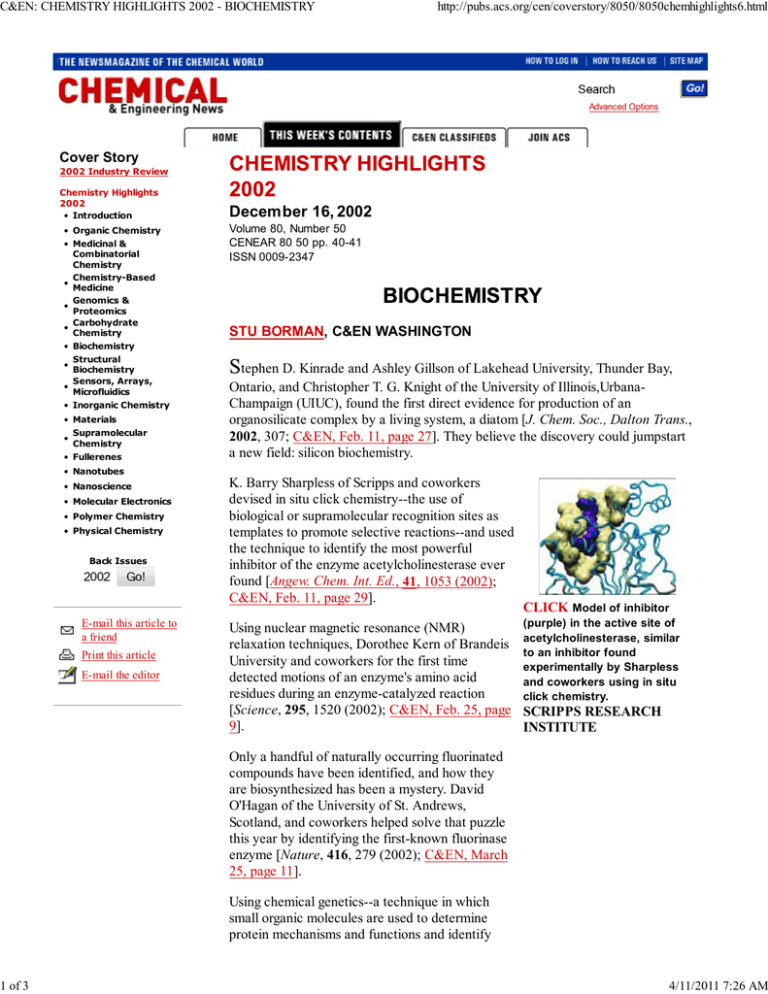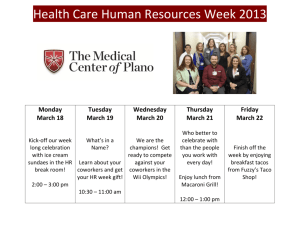
C&EN: CHEMISTRY HIGHLIGHTS 2002 - BIOCHEMISTRY
1 of 3
http://pubs.acs.org/cen/coverstory/8050/8050chemhighlights6.html
Advanced Options
Cover Story
2002 Industry Review
Chemistry Highlights
2002
• Introduction
• Organic Chemistry
• Medicinal &
Combinatorial
Chemistry
Chemistry-Based
•
Medicine
Genomics &
•
Proteomics
Carbohydrate
•
Chemistry
• Biochemistry
Structural
•
Biochemistry
Sensors, Arrays,
•
Microfluidics
• Inorganic Chemistry
• Materials
Supramolecular
•
Chemistry
• Fullerenes
December 16, 2002
Volume 80, Number 50
CENEAR 80 50 pp. 40-41
ISSN 0009-2347
STU BORMAN, C&EN WASHINGTON
tephen D. Kinrade and Ashley Gillson of Lakehead University, Thunder Bay,
Ontario, and Christopher T. G. Knight of the University of Illinois,UrbanaChampaign (UIUC), found the first direct evidence for production of an
organosilicate complex by a living system, a diatom [J. Chem. Soc., Dalton Trans.,
2002, 307; C&EN, Feb. 11, page 27]. They believe the discovery could jumpstart
a new field: silicon biochemistry.
• Nanotubes
• Nanoscience
• Molecular Electronics
• Polymer Chemistry
• Physical Chemistry
Back Issues
E-mail this article to
a friend
Print this article
E-mail the editor
K. Barry Sharpless of Scripps and coworkers
devised in situ click chemistry--the use of
biological or supramolecular recognition sites as
templates to promote selective reactions--and used
the technique to identify the most powerful
inhibitor of the enzyme acetylcholinesterase ever
found [Angew. Chem. Int. Ed., 41, 1053 (2002);
C&EN, Feb. 11, page 29].
CLICK Model of inhibitor
(purple) in the active site of
acetylcholinesterase, similar
to an inhibitor found
experimentally by Sharpless
and coworkers using in situ
click chemistry.
Using nuclear magnetic resonance (NMR)
relaxation techniques, Dorothee Kern of Brandeis
University and coworkers for the first time
detected motions of an enzyme's amino acid
residues during an enzyme-catalyzed reaction
[Science, 295, 1520 (2002); C&EN, Feb. 25, page SCRIPPS RESEARCH
9].
INSTITUTE
Only a handful of naturally occurring fluorinated
compounds have been identified, and how they
are biosynthesized has been a mystery. David
O'Hagan of the University of St. Andrews,
Scotland, and coworkers helped solve that puzzle
this year by identifying the first-known fluorinase
enzyme [Nature, 416, 279 (2002); C&EN, March
25, page 11].
Using chemical genetics--a technique in which
small organic molecules are used to determine
protein mechanisms and functions and identify
4/11/2011 7:26 AM
C&EN: CHEMISTRY HIGHLIGHTS 2002 - BIOCHEMISTRY
2 of 3
http://pubs.acs.org/cen/coverstory/8050/8050chemhighlights6.html
useful forms of bioactivity--Stuart L. Schreiber of
Harvard University and coworkers discovered a
previously unknown glucose signaling pathway in
yeast that may be related to a human diabetesrelated pathway [Nature, 416, 653 (2002); C&EN,
April 15, page 15].
A "Trp-cage miniprotein"--a 20-residue peptide
that folds into a 3-D conformation as if it were a
larger protein--was designed and characterized by
Niels H. Andersen and coworkers at the
University of Washington, Seattle [Nat. Struct.
Biol., 9, 425 (2002); C&EN, April 29, page 24]. A
second group found the observed fold could be
reproduced by molecular dynamics [J. Am. Chem.
Soc., 124, 11258 (2002)], and a third found that
the miniprotein folds in only four microseconds-making it the fastest folding proteinlike system
known
[J. Am. Chem. Soc., 124, 12952 (2002)].
QUAD The first direct
evidence for a G-quadruplex
(shown) in a human gene was
found by Hurley and
coworkers.
HARIPRASAD VANKAYALAPATI/U OF
ARIZONA
Proximity ligation, a technique that uses polymerase chain reaction to identify and
quantitate proteins, was developed by Ulf Landegren and coworkers at Uppsala
University, Sweden [Nat. Biotechnol., 20, 473 (2002); C&EN, May 6, page 43].
They used it to detect a few tens of zeptomoles (40 x 10–21 mol) of plateletderived growth factor.
Floyd E. Romesberg, Peter G. Schultz and coworkers at Scripps used directed
evolution to convert DNA polymerases--which normally catalyze DNA
synthesis--into mutant enzymes that efficiently catalyze RNA synthesis instead
[Proc. Natl. Acad. Sci. USA, 99, 6597 (2002); C&EN, May 20, page 37].
There were believed to be just 20 genetically encoded amino acids in mammalian
cells, with a few organisms also using a 21st. But Joseph A. Krzycki, Michael K.
Chan, and coworkers at Ohio State University discovered a 22nd (l-pyrrolysine) in
a methane-producing microbe [Science, 296, 1459 and 1462 (2002); C&EN, May
27, page 13].
The first ribozymes that catalyze the joining of RNA to protein were developed by
David P. Bartel's group at the Whitehead Institute for Biomedical Research,
Cambridge, Mass. [Proc. Natl. Acad. Sci. USA, 99, 9154 (2002); C&EN, June 24,
page 31].
A group led by Hiroaki Suga of the State University of New York, Buffalo (SUNY
Buffalo), devised an efficient and inexpensive new route to nonnatural proteins
[Nat. Biotechnol., 20, 723 (2002); C&EN, July 1, page 21]. A ribozyme they
developed catalyzes transfer of nonnatural amino acids from donor molecules to
specific tRNAs, which can then incorporate the amino acids into proteins.
The mechanism by which bacteria biosynthesize enediynes like C-1027 and
calicheamicin has been uncertain, but Ben Shen and Jon S. Thorson of the
University of Wisconsin, Chris M. Farnet of Ecopia Biosciences, Montreal, and
coworkers showed that the enediyne cores of both drugs are biosynthesized by a
common polyketide pathway [Science, 297, 1170 and 1173 (2002); C&EN, Aug.
19, page 12].
4/11/2011 7:26 AM
C&EN: CHEMISTRY HIGHLIGHTS 2002 - BIOCHEMISTRY
3 of 3
http://pubs.acs.org/cen/coverstory/8050/8050chemhighlights6.html
The first direct evidence for a G-quadruplex (a boxlike DNA conformation) in a
human gene was obtained by Laurence H. Hurley and coworkers at the University
of Arizona, Tucson [Proc. Natl. Acad. Sci. USA, 99, 11593 (2002); C&EN, Sept.
2, page 9]. The study helps confirm quadruplexes as valid targets for drug design.
Bruce A. Garetz of Polytechnic University, Brooklyn; Allan S. Myerson of Illinois
Institute of Technology, Chicago; and coworkers found that polarized laser
radiation can be used to direct amino acid crystallization toward one polymorphic
form over another [Phys. Rev. Lett., 89, 175501 (2002); C&EN, Oct. 21, page 16].
Ketone groups incorporated biosynthetically into bacterial cell walls provide
chemically reactive sites for surface attachment of a range of nonnatural
compounds [J. Am. Chem. Soc., 124, 9018 (2002); C&EN, Aug. 5, page 11]. The
technique, developed by Shin-Ichiro Nishimura of Hokkaido University, Sapporo,
Japan, and coworkers, has implications for vaccine design and studies of bacterial
surface interactions.
And nanocircles of synthetic DNA that mimic the enzyme telomerase's ability to
lengthen telomeres (chromosome end-caps) were developed by Eric T. Kool of
Stanford and coworkers [Proc. Natl. Acad. Sci. USA, 99, 15953 (2002); C&EN,
Nov. 25, page 18]. The nanocircles could make it possible to grow long-lived
normal human cell lines for research.
Top
Chemical & Engineering News
Copyright © 2002 American Chemical Society
Home | Table of Contents | Today's Headlines | Business | Government & Policy | Science & Technology | C&EN Classifieds
About C&EN | How To Reach Us | How to Advertise | Editorial Calendar | Email Webmaster
Chemical & Engineering News
Copyright © 2002 American Chemical Society. All rights reserved.
• (202) 872-4600 • (800) 227-5558
4/11/2011 7:26 AM



